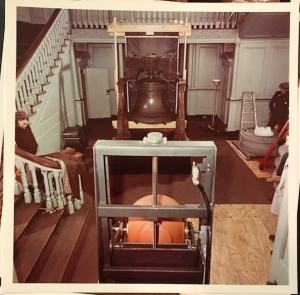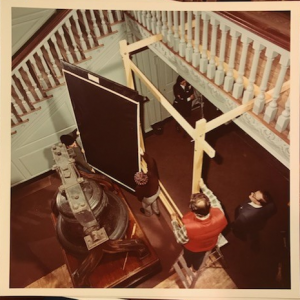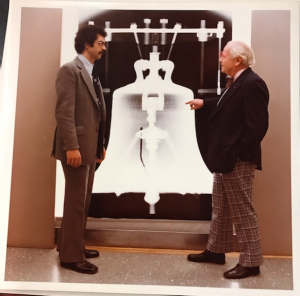My current project in the Special Collections Department has involved the processing of material related to the International Petroleum Exposition (the IPE). The IPE occurred in Tulsa at various intervals between 1923 and 1979. I plan on writing a celebratory blog post about this collection and all the treasures found within when I finish processing it. The collection is quite expansive, so it will probably be a while before I get to write that one!
I recently came across an envelope of photographs while going through the collection that I thought would make a great subject for today. Did you know that in 1975 they x-rayed the Liberty Bell? They did and we have the photographs to prove it. Unfortunately, the photographs are the only thing in the collection documenting this event. There is no associated paperwork in the collection or annotations on the photographs to help me understand who is in them or why they’re related to the collection, but the pictures alone tell a story.
As you can imagine, x-raying something that large without transporting it required some creativity. In these pictures, you can see men setting up a large wooden frame for the x-ray film and using chains with a pulley system to lift up the large x-ray equipment.
As you can see, this process was a lot of work. You may be wondering- why would anybody take the time to x-ray a bell? I wondered the same thing.
The answer came from the National Parks website. They say that the reason that we x-ray the bell is to check for any hidden damage that could make it susceptible to cracking when it is being moved to a new location. While they always do a visual inspection as well, x-ray technology is a unique way to check for cracks in the bell that may be difficult to see with the naked eye.
The bell was last rung in 1846 in honor of George Washington’s birthday, when the large crack spread too far for the bell to ring and it had to be taken out of service. While the bell is not being rung anymore, small cracks could be developing over time and they can become big problems in the hustle and bustle of moving the bell. Even though the bell is already cracked beyond repair, it’s important to continue to preserve this important piece of American history. It is almost 250 years old, so I suppose it is at an age where regular medical examinations are extremely important!
These photographs were taken in the bell’s long-time home in Independence Hall, right before they moved it to a new home on Independence Mall. The bell was even x-rayed again in 2001 after a man struck the bell with a hammer after a tour, damaging it. This was also done to prepare for the bell’s next move to the Liberty Bell Center in 2003.
I am not sure yet how this small envelope of photographs pertains to the IPE, but they sure did tell a story. There are so many quirky treasures hidden within our collections, we get to see something new every day. If you’re interested in viewing them in person or other objects that we have here at Special Collections, please come visit us on the fifth floor of the McFarlin Library on weekdays between the hours of 8 and 4:30.





